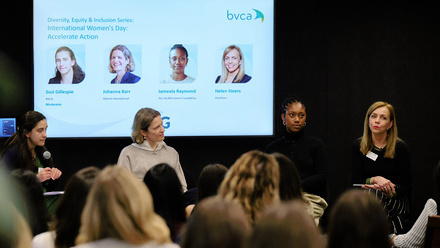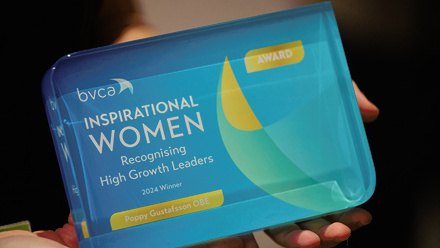Neurodiversity in the workplace: how we can harness creativity, innovation and entrepreneurship
On 22 January, ICG hosted and sponsored a Neurodiversity Reception in their London office, as part of the BVCA’s Diversity Equity & Inclusion (DEI) series. The panel discussion included Natalie Whiley as moderator (Head of Industry Development, BVCA), Mel Francis (Director of Neurodiversity at Work, Do-IT Solutions Ltd), Tom Vodden (Business Psychologist and Organisational Development Consultant, Lexxic) and Tom Smith (Investment Director, BoxFund).
Breeze Haywood, BVCA’s Sustainability Executive, reflects on the conversation and how businesses can build a neuroinclusive workplace.
As societies are increasingly supporting diversity equity and inclusion (DEI), the imperative to embrace neurodiversity within the professional world is becoming ever more present. Despite this trend, currently 72% of employees do not tell their employers that they have a neurodivergent condition over fears that this could negatively impact their career. During the BVCA’s most recent DEI series, panellists advocated the need for businesses to both adapt to and drive change within their organisations, not only for the benefit of their future workforces, but to champion cultural, productive and sustainable change that enhances overall business performance.
The event exuded a strong recognition and celebration of neurodiversity in the workplace and offered insights into how best we can harness the qualities that neurodiverse employees bring to the table. Panellists discussed the importance of reframing our understanding of neurodiversity and the need to build neuroinclusive workplaces that can meaningfully support employees and enrich organisations.
The business case for neurodiversity
Historically, narratives surrounding neurodiversity have often had negative social implications that derive from a range of misleading stereotypes, leading people to associate neurodivergent conditions with a lack of workplace productivity.
A core message from the panel discussion was that neurodiversity indeed represents a valuable and underutilised source of talent, creativity, and innovation. If neuroinclusive strategies are properly implemented, they can boost productivity, employee wellbeing and performance. Building this environment encourages alternative perspectives that can advance ingenuity and entrepreneurship in businesses.
Neurodiversity is a strategic imperative
Throughout the panel discussion, it was made clear that businesses should not underestimate the value of diverse minds if they want to harness unique qualities that would enrich the workplace. Clear and meaningful DEI policies are becoming a priority and a key indicator of an attractive workplace. If organisations do not foster a neuroinclusive environment, not only can valuable qualities be squandered from existing employees, but it can negatively impact retention rates. Our panel speakers highlighted that GenZ individuals are more likely to apply for jobs that are neuroinclusive, which could result in organisations losing talent if no action is taken. At a recruitment level, the panel discussed how companies could reassess whether they are attractive to prospective employees and be proactive in providing tools and resources that are useful to neurodiverse people, highlighting that the business is open for all minds.
Building a neuroinclusive workplace:
Throughout the discussion, panellists shared their insights on how businesses can effectively build neuroinclusive workplaces which begins with investors and senior leaders valuing intersectional diversity, by consciously integrating this in their investment decision-making at both senior and junior levels. An intersectional approach means taking into account people’s overlapping identities such as race, gender and ability, all of which shape an individual’s experiences and opportunities. Choosing to make decisions through an intersectional lens would not only benefit existing employees but also introduce a wider array of skills and perspectives that the company can utilise to its advantage.
Suggestions shared by the panel exemplified how companies can be instrumental in creating neuroinclusive spaces, simply by starting the conversation and generating a culture of understanding and awareness. This can be done through several avenues. Company-wide workshops and presentations that educate people on neurodiversity can be an efficient way to lay the foundations in developing this inclusive environment. Building on this, smaller focus groups where employees provide suggestions to improve certain company processes, culture and the physical environment can offer a valuable way for employees to candidly provide feedback that would inevitably benefit the company’s culture and productivity. One of the panellists strongly recommended that companies should invest in having a team member that is a specialist in neurodiversity, so employees have a reliable point of contact in their workplace.
Attendees heard how neurodiversity can be a tangible benefit to companies, so organisations should be clear in committing to building inclusive spaces, rather than treating it like a tick-box exercise. By adapting to an approach that celebrates the different skills and qualities that employees bring to the table, businesses can transform what the organisation can achieve to the benefit of everybody.

Authored by Breeze Haywood
Sustainability Policy Executive, BVCA





